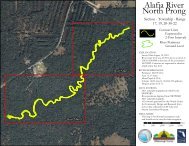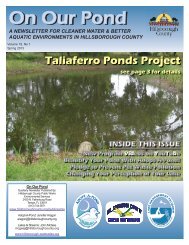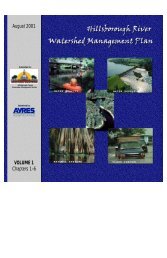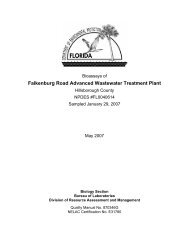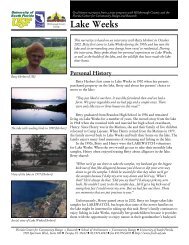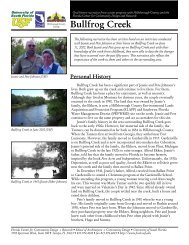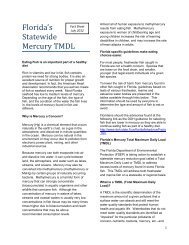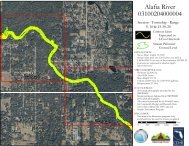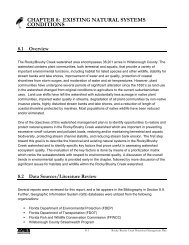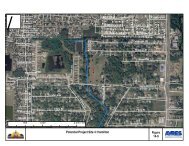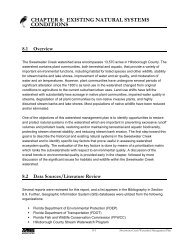Lithia Springs EcoSummary - Hillsborough County & City of Tampa ...
Lithia Springs EcoSummary - Hillsborough County & City of Tampa ...
Lithia Springs EcoSummary - Hillsborough County & City of Tampa ...
Create successful ePaper yourself
Turn your PDF publications into a flip-book with our unique Google optimized e-Paper software.
<strong>EcoSummary</strong><strong>Lithia</strong> <strong>Springs</strong>, <strong>Hillsborough</strong> <strong>County</strong>.Alafia River WatershedAugust 19, 1998BioRecon: A rapid, cost-effective screening mechanism for identification <strong>of</strong> biological impairment.PurposeSurface water samples were collected from <strong>Lithia</strong> <strong>Springs</strong> in order to gain further information on theecological health <strong>of</strong> the watershed for use in the administration <strong>of</strong> Florida's Ecosystem ManagementWater Quality Assessment (EMWQAS) and Total Maximum Daily Loads programs. All workconducted by EMWQAS was conducted according to established DEP standard operating proceduresand quality assurance plans.Background<strong>Lithia</strong> <strong>Springs</strong> is located in north-central <strong>Hillsborough</strong> <strong>County</strong> and flows into the Alafia River. Itdischarges an average <strong>of</strong> 1.4 m3/s and contributes up to 25% <strong>of</strong> the total flow in the river during thedry season. It is a large seawalled spring that has been operated as a public swimming area for manyyears. The basin is largely rural, with low to medium level residential development and agriculturallanduse. A study published in 1993 by SWFWMD reported the average total nitrogen concentrationsemanating from <strong>Lithia</strong> <strong>Springs</strong> to be 3.1 mg/l, due to excessive nitrates. The source <strong>of</strong> the nitrates wasdetermined to be inorganic fertilizers applied to citrus groves, with minor animal-waste contributions(dairy).ResultsWater chemistry samples were taken just below the spring vent, in a shallow sandy area. No biologicalassessment was performed, but large numbers <strong>of</strong> grazing gastropods (Elimnia) were observed. Thewater was clear and aqua. The canopy was open and periphyton was abundant. Dissolved oxygen(DO) was below the State Standard <strong>of</strong> 5.0 mg/. However, we were sampling groundwater, so low DOwould be expected. The total nitrogen (TN) concentration was excessive due to very high nitrate levels(2.9 mg/l). Total phosphate (TP) was quite low as compared to typical values <strong>of</strong> Florida streams. Totaland fecal coliforms were well within the single-sample State Water Quality Standard.SignificanceThe excessive level <strong>of</strong> nitrate-nitrogen emanating from the spring indicates contamination <strong>of</strong> the
surficial aquifer from current and/or historical landuse practices. The SWFWMD study identifiesfertilization <strong>of</strong> citrus groves to be the main source <strong>of</strong> the nitrates. In recent years, residentialdevelopment has increased in the vicinity <strong>of</strong> the Spring. The study speculates that increased numbers<strong>of</strong> septic tanks will likely affect the future concentrations and sources <strong>of</strong> nitrogen in the Spring. Thesehigh levels <strong>of</strong> nitrates, while they may not present a health hazard, provide nutrients for potential algalblooms and vegetative overgrowths that may result in an imbalance <strong>of</strong> fauna and flora, periodicdissolved oxygen depletion and eutrophication. This may not be evident in the Alafia River until thelower estuary portion where water velocity decreases and nutrients accumulate in the sedimentsSuggestionsThere is not much that can be done to reduce the present nitrate loading from Rainbow <strong>Springs</strong>, as itrepresents historic landuse practices, for the most part. It could take decades for the aquifer to flushout, and in the mean time residential development may introduce other potential sources <strong>of</strong> nitrogen. Itis important for residents <strong>of</strong> the area to be conservative in the care <strong>of</strong> their lawns, refraining fromexcessive fertilization that would sustain the nitrate contamination. Maintaining natural vegetation andreducing grass lawn area can reduce the amount <strong>of</strong> fertilizer needed. The use <strong>of</strong> slow-release organicfertilizers, which are utilized more efficiently by vegetation, would reduce the amount <strong>of</strong> nitrogengetting in the ground water. Also, if future monitoring indicates septic tank effluent is affecting theSpring, <strong>Hillsborough</strong> <strong>County</strong> should pursue conversion to sewers or alternative on-site systems thatmore effectively remove nitrogen.For more information, please contact:Peggy MorganDEP Southwest District 3804 Coconut Palm Drive <strong>Tampa</strong>, Florida33619(813) 744-6100email: morgan_p@tpa1.dep.state.fl.usPublished by the Florida Department <strong>of</strong> Environmental Protection,Tallahassee, FL.For more information on the DEP Bioassessments program, pleasevisit our website at http://www2.dep.state.fl.us/water/Slerp/bio/



